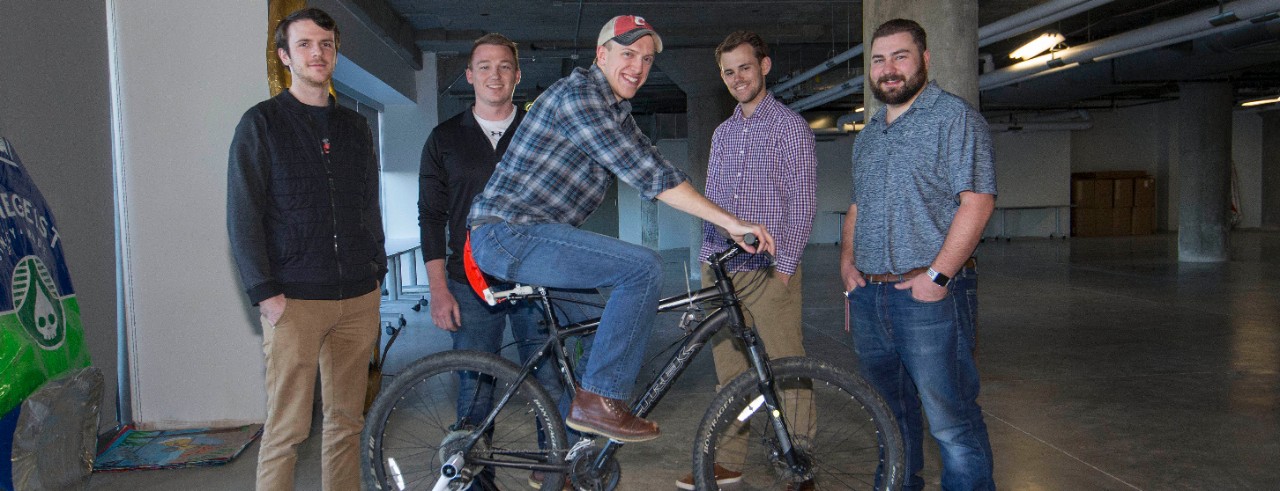
UC design lets disabled cyclist return to road
Engineering students design a 'butt brake' for riders who can't grip handlebars tightly. They are working with a nonprofit group to develop adaptive technology
Students from the University of Cincinnati are using their senior capstone projects to solve problems facing veterans with disabilities.
The students accepted a challenge from the nonprofit group Quality of Life+ (QL+) to come up with adaptive technologies for military veterans with disabilities. The charitable organization helps veterans find creative solutions to everyday problems.
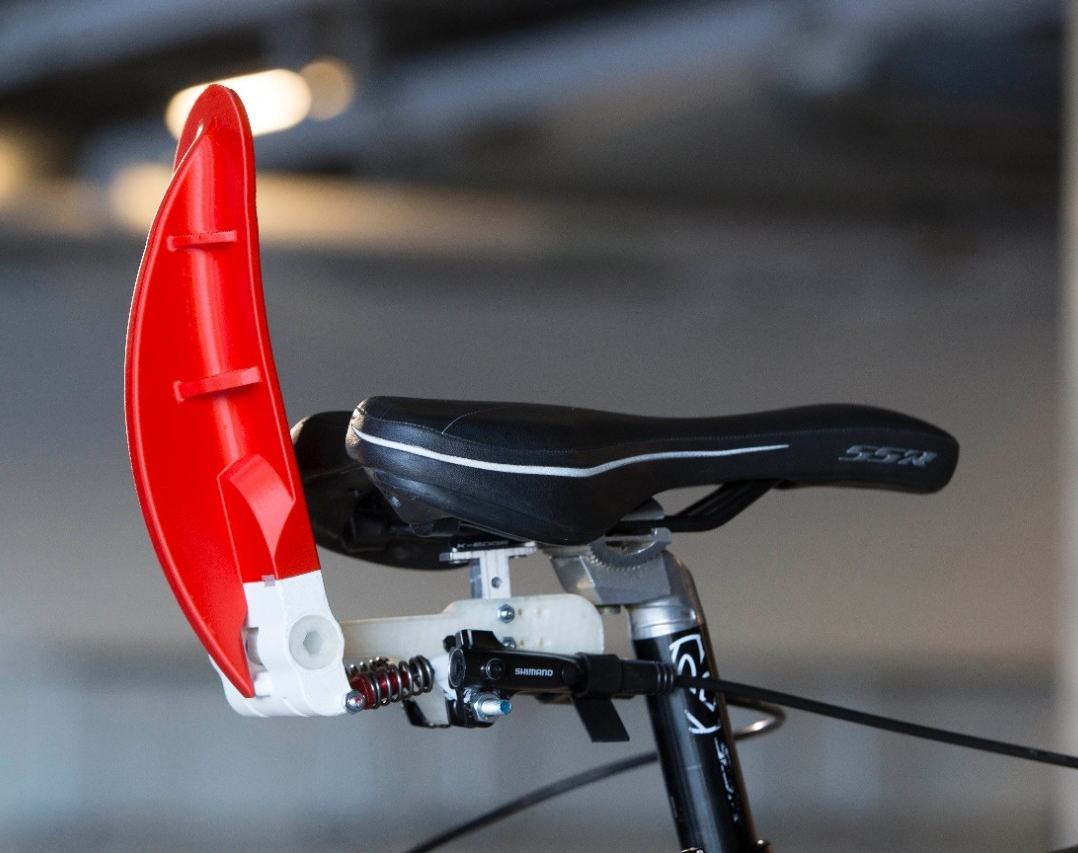
UC engineering students designed a brake paddle that riders activate by leaning back in their seat instead of using hand brakes. Photo/Joseph Fuqua II/UC Creative Services
The project demonstrates UC’s commitment to using innovation to make a difference in the world as outlined in its strategic plan called Next Lives Here.
Mechanical engineering students in UC’s College of Engineering and Applied Science designed and manufactured a custom bicycle brake for U.S. Army veteran Ashley Crandall, a rider from Maine who sometimes has trouble gripping handlebar-mounted brake levers.
The students considered the problem from various angles and settled on the posterior — designing what they call a “butt brake” that is activated when a rider leans back against a paddle that presses against his or her lower back.
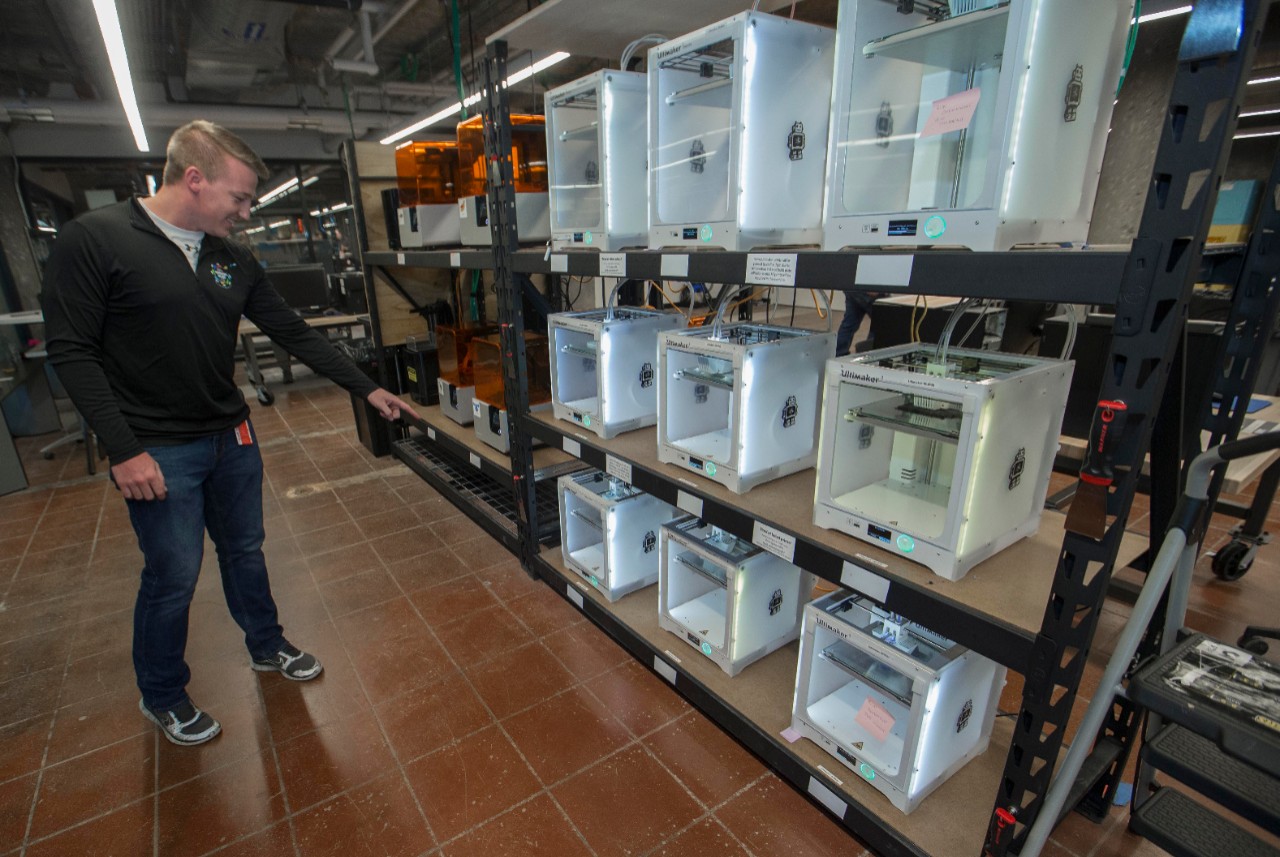
UC engineering students used the 3D printers at the 1819 Innovation Hub to manufacture parts for their custom brake. Kyle Rickett gets ready to remove a finished part. Photo/Joseph Fuqua II/UC Creative Services
Students gathered at the UC 1819 Innovation Hub’s makerspace — "the Ground Floor" — where they used its 3D printers to create parts for the device. During an initial test run, one of the plastic pieces failed so they rebuilt it using milled aluminum.
Then they gathered around a workbench and assembled the parts. Unlike conventional cable brakes found on most bicycles, the UC engineers decided to use a hydraulic system, student Timothy Jones said.
“It’s often used in wet applications,” Jones said. “You see it in mountain bikes. It’s more resilient in bad weather. With cable brakes, water can get into the brake pads.”
Being able to ride a bike on a regular basis will not only help me to become healthier physically, but it will also enable me to reconnect with the cycling community.
Ashley Crandall, U.S. Army veteran
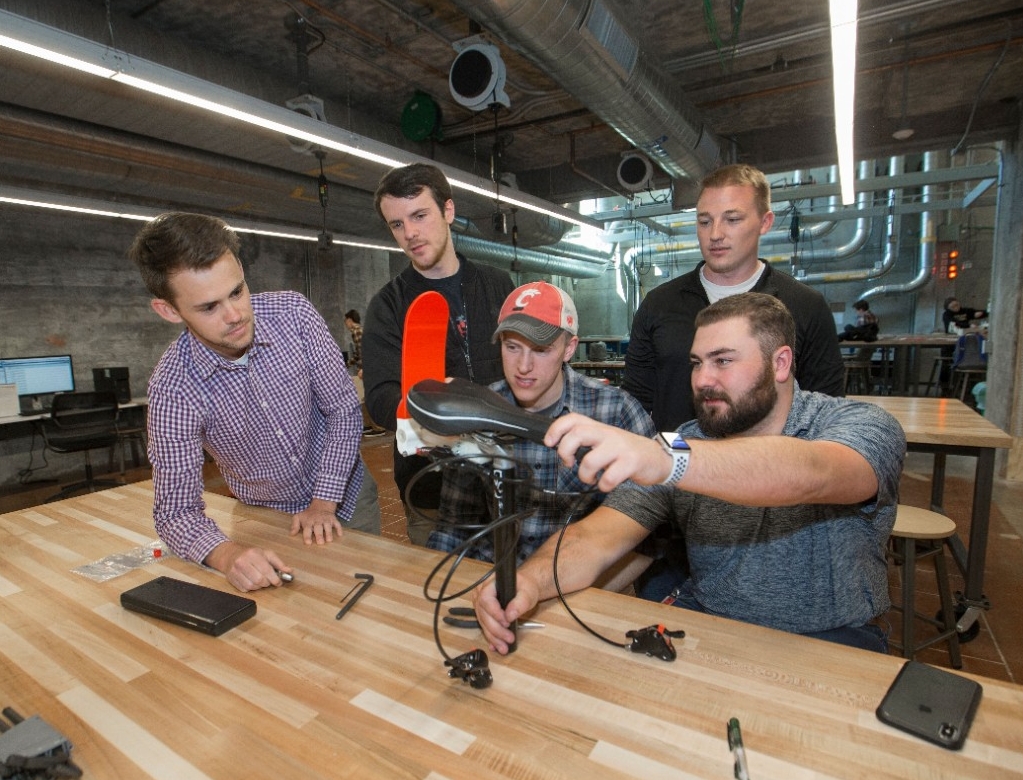
UC engineering students discuss the mechanics of the brake they are assembling in the maker space of the 1819 Innovation Hub. From left they are Brian Heldman, David Schulte, Timothy Jones, Kyle Rickett and Josh Baker. Photo/Joseph Fuqua II/UC Creative Services
The students designed the brake with safety and practicality in mind. The strong but lightweight paddle — 3D-printed in UC red, naturally — attaches to the braking mechanism with heavy magnets so that it detaches harmlessly in a crash.
Once assembled, the students placed a test bicycle on a stationary rack and tried it out. After getting the wheels going to maximum speed, a student leaned back on the paddle and the wheel came to quick and firm stop, prompting whoops of excitement.
The braking system has applications for any rider who has trouble gripping traditional handbrakes. But UC students had Army veteran Crandall in mind.
Crandall worked as an aircraft mechanic on Kiowa Warrior and Black Hawk helicopters during her 10 years in the military. She sustained a traumatic brain injury from a fall while she was deployed to Kuwait in 2008.
“I love to cycle and have attended 30 different weeklong bike rides,” she said in a blog post to QL+. “Some of my conditions are progressive and possibly life-threatening, so I don’t know how long I’ll be able to do the things I love. I’m surrounded by people who don’t allow their physical limitations get in the way of the life they desire.”

UC students make final adjustments to their custom brake at the 1819 Innovation Hub. Photo/Joseph Fuqua II/UC Creative Services
Crandall said the brake UC students are working on will help her get back on a bicycle for regular rides after more than a year of recuperating from related health issues.
“Being able to ride a bike on a regular basis will not only help me to become healthier physically, but it will also enable me to reconnect with the cycling community that I lost contact with during that year,” Crandall said.
Crandall said UC students are doing a big service to help disabled riders get back to doing what they love.
“I joined the military because I believe in service to others. As participants in this program, you obviously adhere to the same tenets,” she said. “Every good thing in my life started from someone reaching out a hand, and every amazing opportunity that I've had has been the result of me doing the same.”
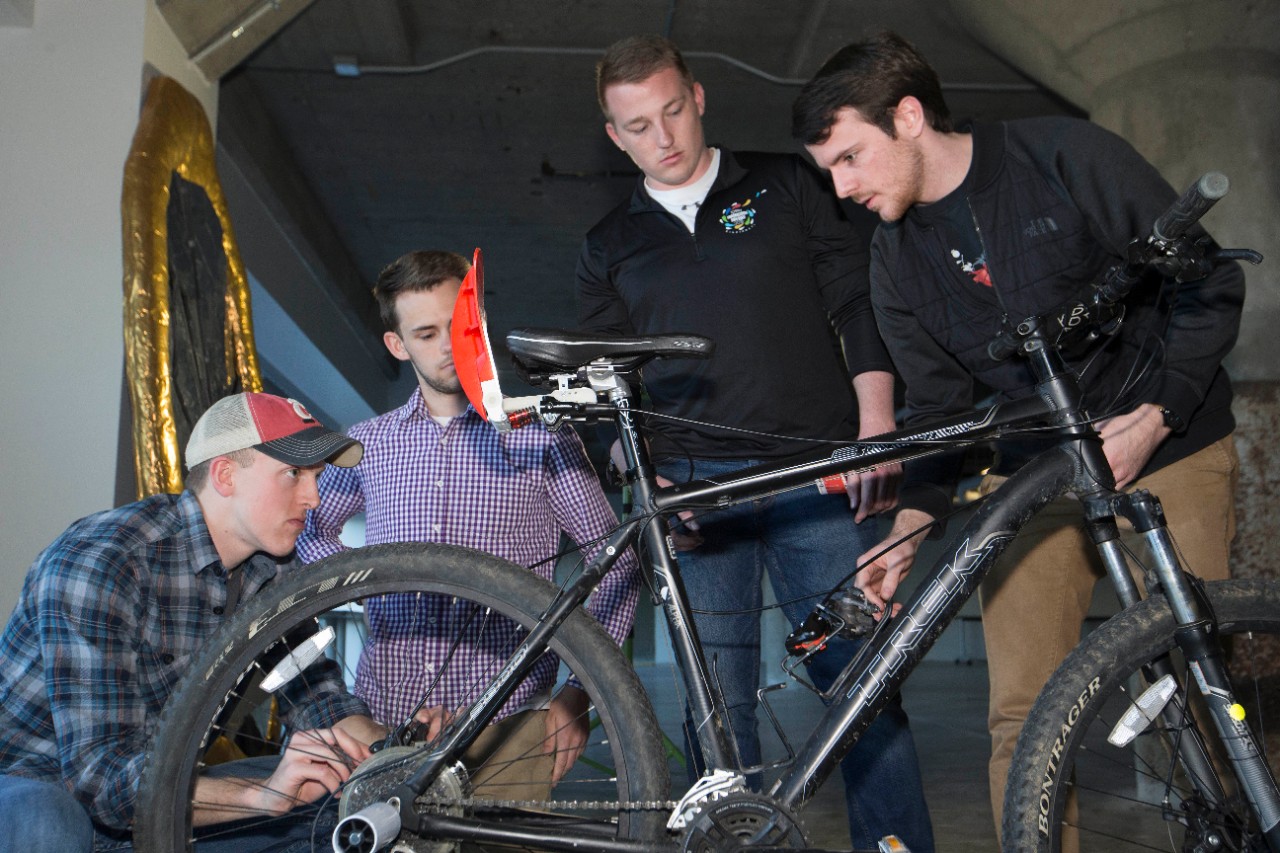
UC engineering students make final adjustments to their custom brake at the 1819 Innovation Hub. From left they are Timothy Jones, Brian Heldman, Kyle Rickett and David Schulte. Photo/Joseph Fuqua II/UC Creative Services
UC mechanical engineering students also created an adaptive technology for a Cincinnati veteran, Mike Donnelly, who needs help installing a scooter rack on his truck when he wants to travel.
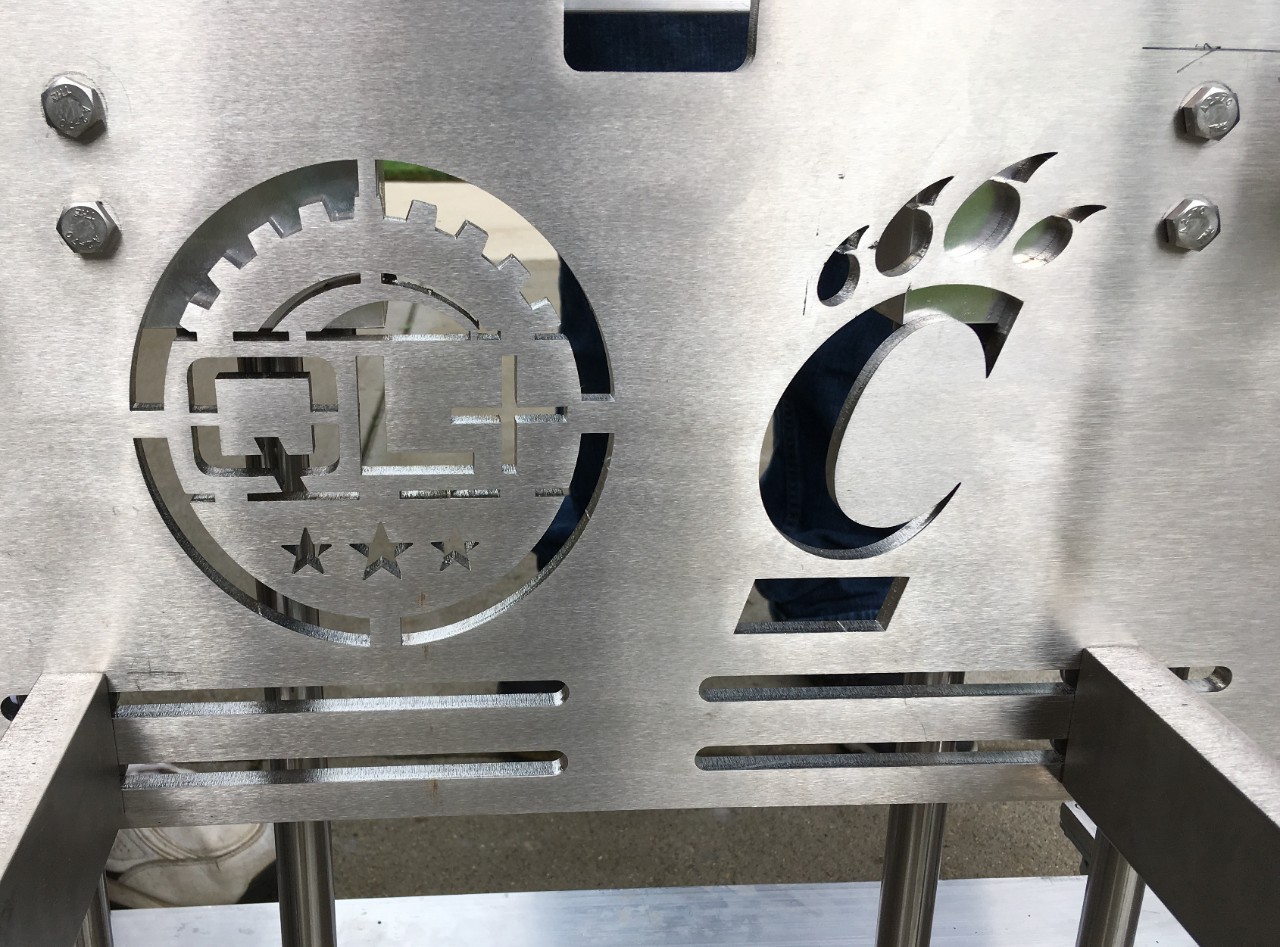
UC engineering students used a laser cutter to carve the Bearcat logo and the logo for project sponsor QL+ into the frame of the winch.
Donnelly, a U.S. Army veteran who served in the Vietnam War, said he can’t park his truck in his garage with the heavy and ungainly scooter rack attached. So he has to enlist the help of family or friends to install or remove it, which limits his freedom to travel where and when he pleases.
UC engineering students made a custom lift he can use to attach or detach the scooter rack himself.
The aluminum frame sits on casters with a forklift-style winch that can lift or lower the scooter rack so it simply slides onto the truck's tow mount, mechanical engineering graduate Zac Davis said.
"The lift can easily carry three times the weight of the rack. So we designed it for safety," Davis said.
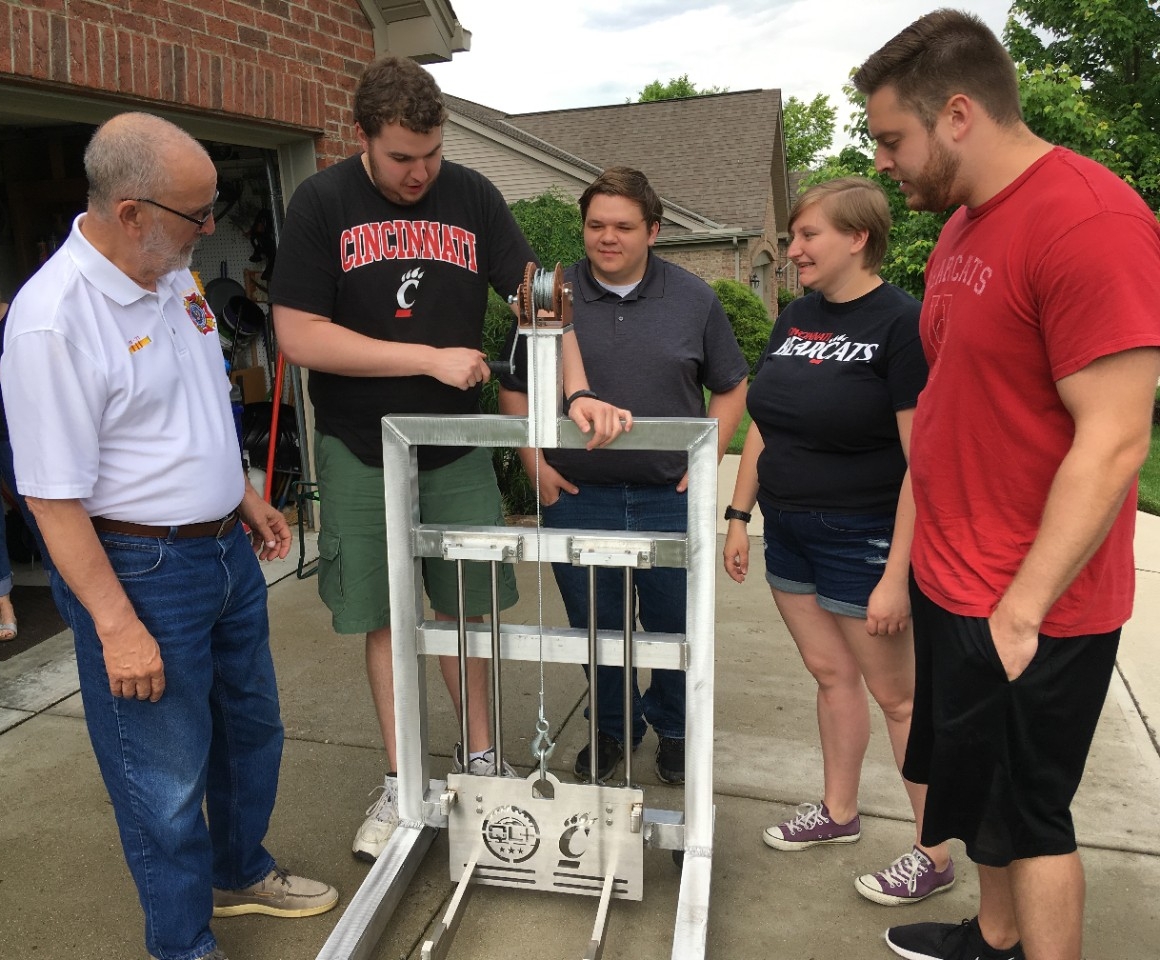
UC engineering graduates deliver the winch to Cincinnati veteran Mike Donnelly, far left, at his home. The aluminum-framed winch will help him attach a heavy scooter lift to the back of his truck without assistance. From left the UC mechanical engineering students are Noah Shaefer, Lincoln Wassink, Makenzie Timmerman and Zac Davis. Not pictured is Chase Zivcsak. Photo/Michael Miller
UC graduate Makenzie Timmerman said they used a computer-drafting program to design the lift and built a prototype out of wood. The final version was made from aluminum and stainless steel with a heavy cable and winch that requires little force to raise or lower the rack.
"The winch was the important part," UC graduate Noah Shaefer said. "We had to find just the right one."
They assembled the lift at UC's Victory Parkway campus with assistance from the engineering firm R.A. Jones based in Covington, Kentucky. The students, all recent graduates, delivered the winch to Donnelly in May.
Donnnelly was impressed.
"This is really nice," he said, leaning over to take a closer look at the Bearcat logo laser-cut into the frame.
“They were over to the house three or four times taking measurements. There was a tremendous amount of engineering that went into it,” Donnelly said. “You can tell it’s well-designed just looking at it.”
Donnelly said these projects make a big difference to the people they help.
“This will give me some newfound freedom. I can go places I couldn’t go before with the scooter,” he said.
UC engineering graduate Lincoln Wassink said he was grateful to work on a senior capstone project that made a real-world impact.
"A lot of what we do is theoretical or in the classroom," Wassink said. "But when QL+ said the project they had in mind would help someone, especially a veteran, it made the effort completely worthwhile."
Featured image at top: UC engineering students show off their functioning custom brake at the 1819 Innovation Hub. From left they are David Schulte, Kyle Rickett, Timothy Jones, Brian Heldman and Josh Baker. Photo/Joseph Fuqua II/UC Creative Services
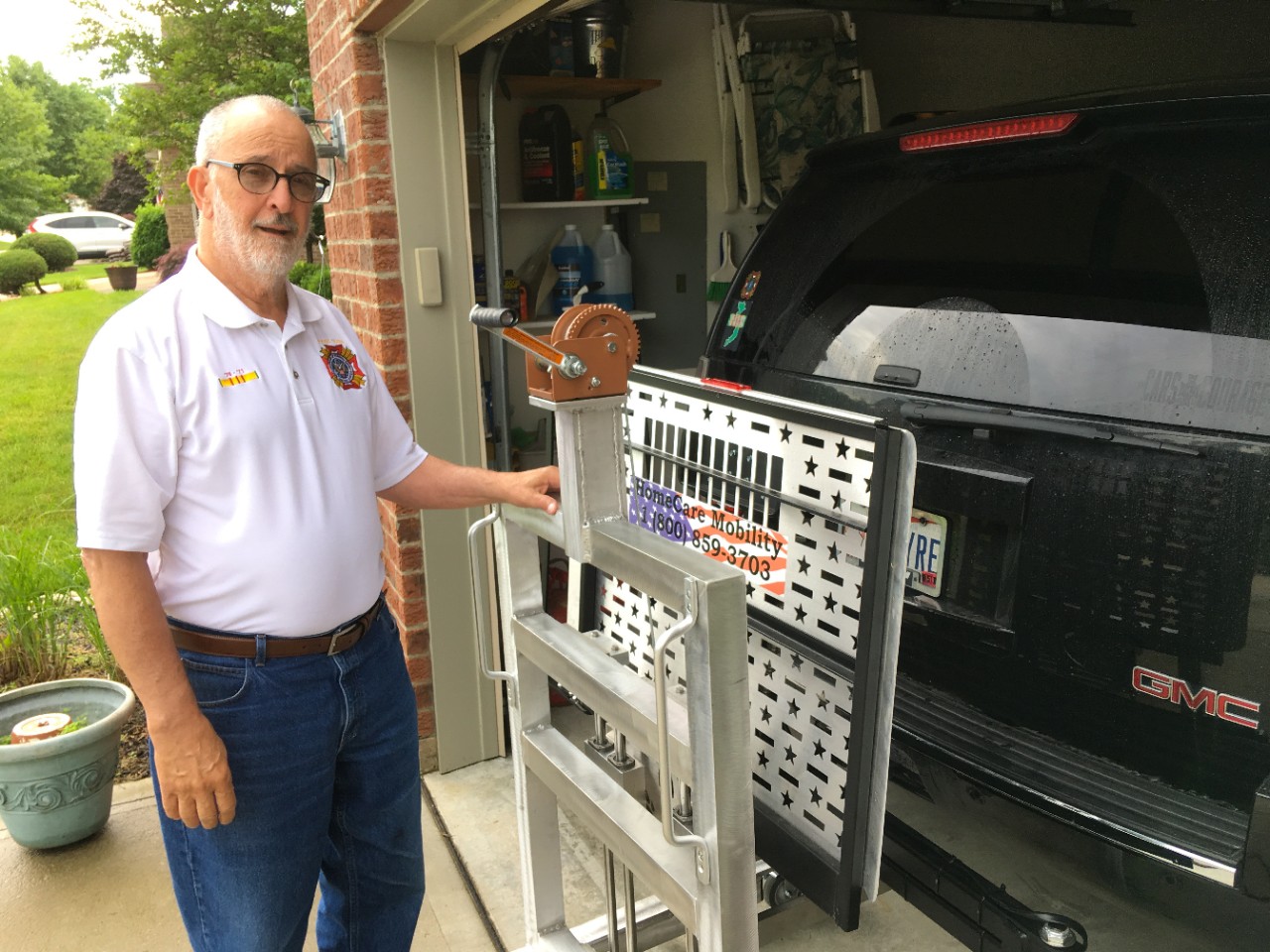
Cincinnati veteran Mike Donnelly stands next to the lift UC students built that enables him to attach his heavy and cumbersome scooter rack to the back of his truck without assistance. Now he can remove the rack himself when he returns from a trip and close his garage door. Photo/Michael Miller
Help for veterans
Do you know a disabled veteran in need of some creative solutions or adaptive technology to improve their lives? QL+ is offering its assistance in providing adaptive technologies to meet individual needs. Contact Amber Humphrey at amber.humphrey@qlplus.org
Next Lives Here
The University of Cincinnati is classified as a Research 1 institution by the Carnegie Commission and is ranked in the National Science Foundation's Top-35 public research universities. UC's graduate students and faculty investigate problems and innovate solutions with real-world impact. Next Lives Here.
Related Stories
Upstream river flooding becoming more common
January 3, 2025
WVXU talks to UC Assistant Professor Dongmei Feng about her new study in Nature examining water flow in the world's rivers. She found that flooding is becoming more common in upstream sections of rivers.
Engineering alumnus honored for impact in tech industry
January 3, 2025
With more than 40 years of experience in technical computing, enterprise software, and engineering simulation, University of Cincinnati alumnus Jim Cashman’s career has spanned leadership roles at the forefront of the tech industry. During his 22-year tenure at ANSYS, including 16 years as CEO, he grew the company into the global leader in engineering simulation software, and helped organizations from Tesla to NASA innovate through virtual prototypes. Cashman was honored with the 2024 Lifetime Achievement Award by the UC Alumni Association and the College of Engineering and Applied Science.
New platform connects biotech innovators with market opportunity
January 3, 2025
Exit Lab brought together leading biotech innovators focused on wearable biosensors to showcase their devices and help them either enter the market or license their technologies.
